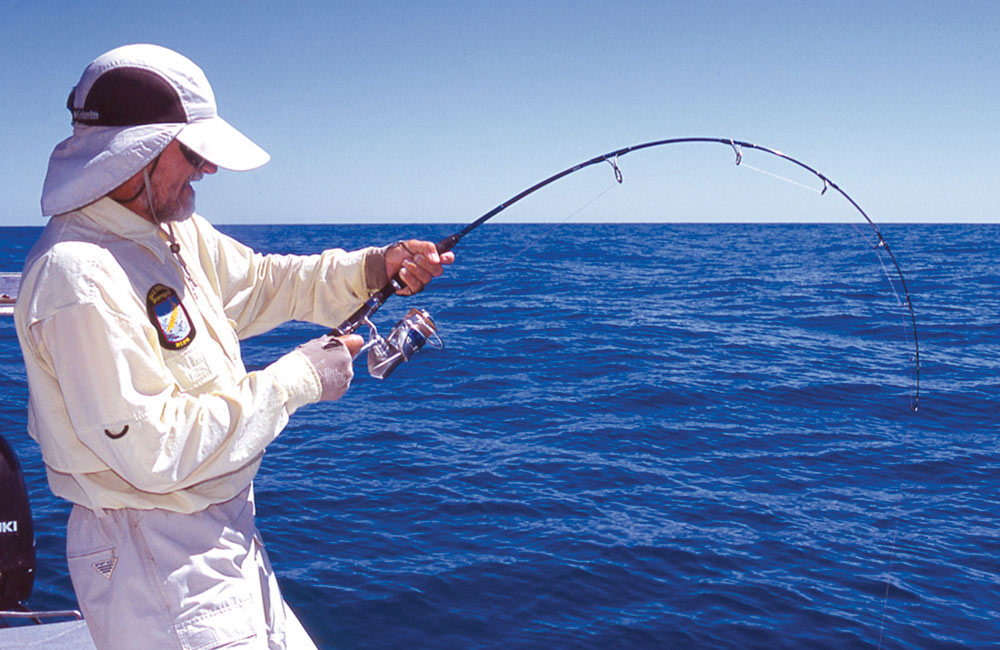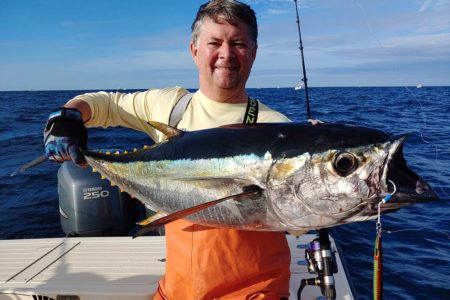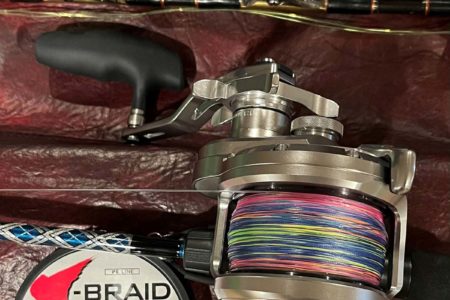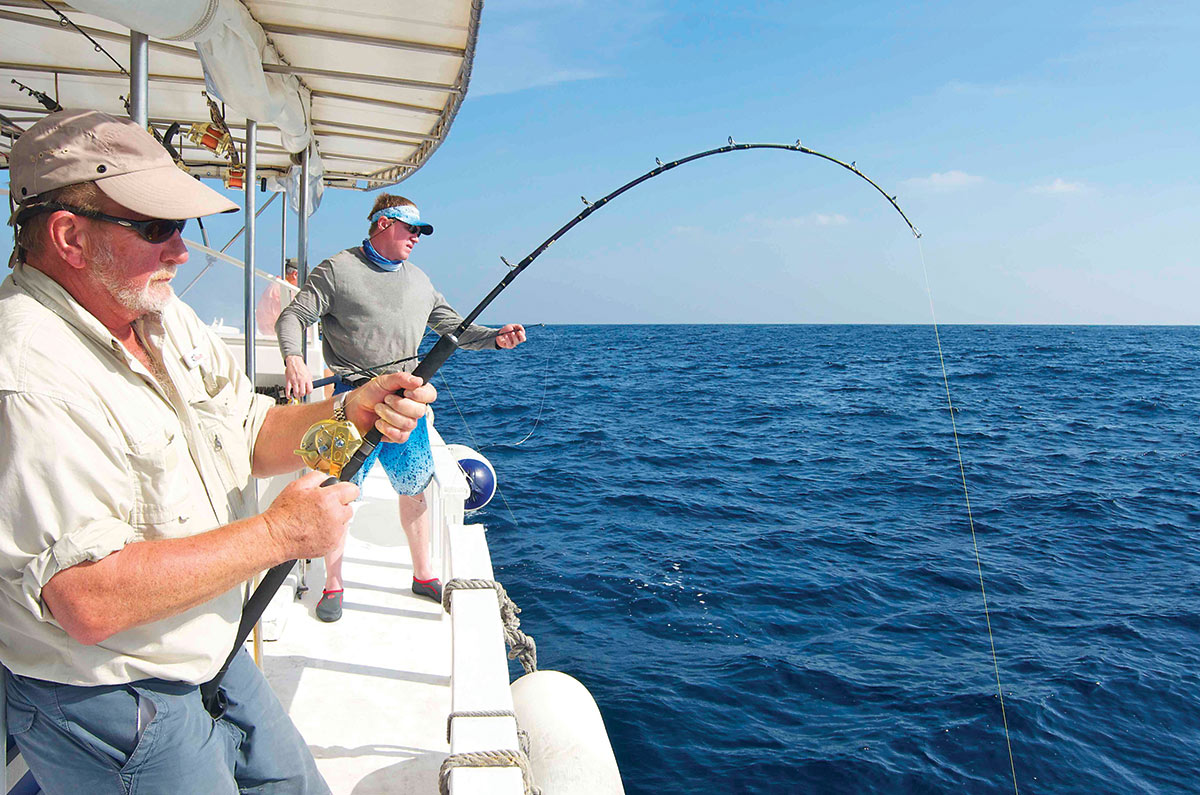
Understanding the nuances of drag settings can help avoid the painful loss of that long sought trophy fish.
“Oh man Tony, I don’t want to jinx it, but I’m sure I just hooked into the fluke of my lifetime” stated my very anxious brother-in-law Seymour, during an ocean fluking trip in 65 feet of crystal clear water this past June. Judging by the strain of Seymour’s 7-foot Lamiglas conventional stick, surely it was no exaggeration that my bro was hooked up with something strong enough to cause heavy beads of sweat to pour from his face and forehead. “Keep the rod tip up and reel slow and steady and for heaven’s sake, don’t pump that rod whatever you do,” I replied. With less than 10 feet to go before the beast would be at the surface, we saw color. At first I thought he was hooked into a big skate, but as the fish drew closer to the boat, it became clear that Seymour was indeed hooked into one heck of a fluke. The fish had to be all of 15 pounds, if not a few pounds more. With the net in hand and the monster seemingly calm just below the surface, experience has taught me that landing such a creature was not going to be as simple as it looked, since once those jumbo flatties catch wind of a net coming their way, all hell breaks loose, and this fish was no different. With the fluke desperately lunging for freedom and taking a good amount of drag with it, I screamed to Seymour not to touch the drag as it was preset at three pounds. However Seymour’s patience grew thin and he went ahead and tightened the drag, bringing a quick and frustrating end to the battle. The fatal flaw occurred once Seymour clamped down on the drag, causing the fluke rig attached to the leader to snap on the fish’s final lunge for freedom. Sadly, instances such as this are common with many species of fish and can simply be avoided with a properly set drag.
Understanding Drag Systems
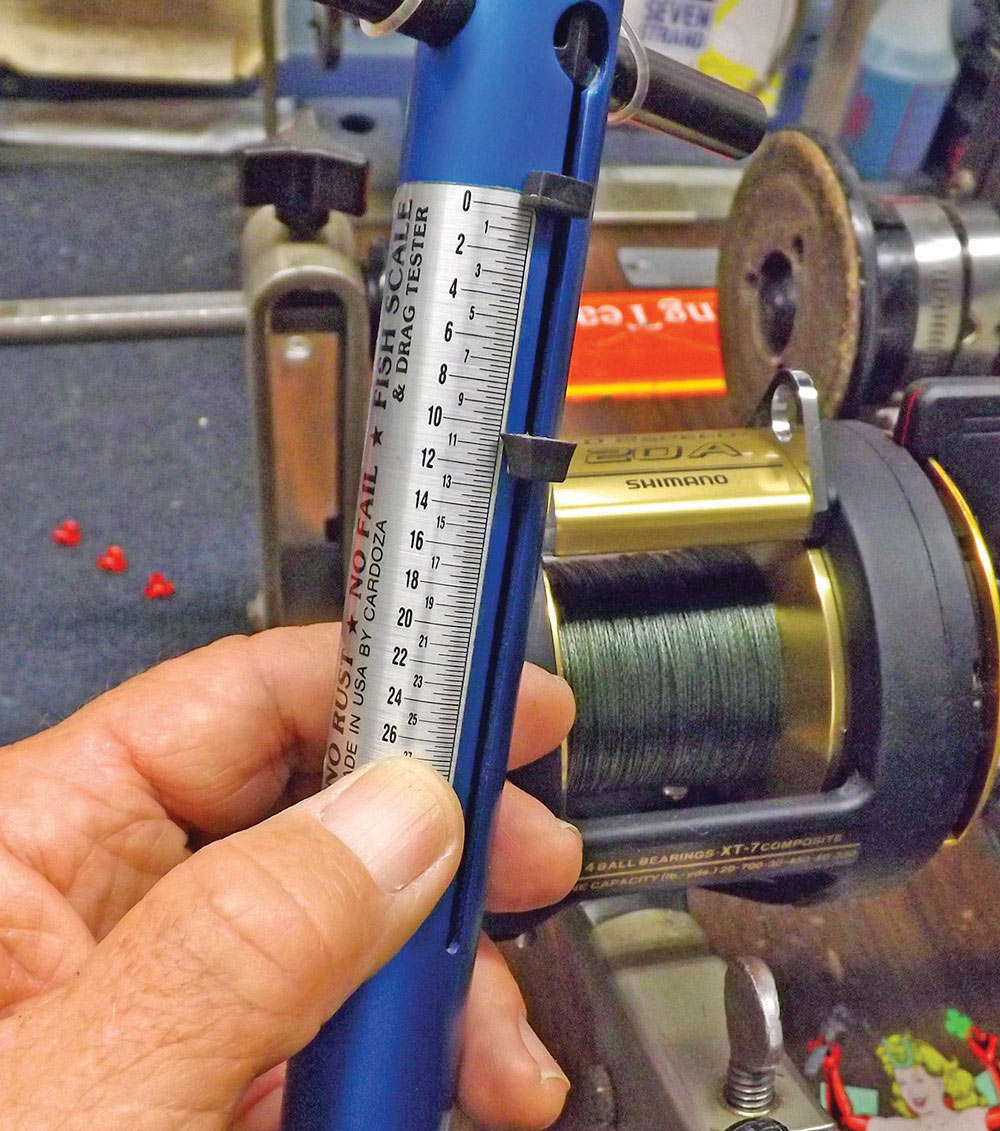
A drag system is basically a brake pad, designed to keep your line from snapping. The pad is positioned so it presses against a series of washers and pads, which then press on the spool. Different manufacturers might use different materials, more pads, thicker or thinner pads, or position the brake pad slightly differently, but all drags work in the same basic way. Each of the three reel types has its own type of drag system, but they all work on the same principle. If you tighten the drag all the way, the spool doesn’t give at all, sort of like tying your line to the dock. Loosen it all the way and line will pour freely off the spool, or in some cases, the spool actually comes off. This is how many spinning systems work; the screw that holds the spool on is the same knob used to tighten the drag down. Tightening the screw or handles presses down on a brake plate, which tightens a series of washers, increasing the pressure in tiny increments. This tension slows the rate of line coming off the spool when a big fish is pulling line off the reel. The sound of line leaving your reel’s spool is a good thing.
Let the Drag Do Its Job
Indeed, losing a big fish to a snapped line or pulled hook can sting for quite some time. However, the loss of most big fish can often be avoided with some minor adjustments to the drag. Applying just the right amount of pressure throughout the battle is crucial to consistently landing quality fish. The drag on a reel is responsible for exerting constant pressure on a fish to wear it down. In addition, the drag acts as a buffer to prevent tension from reaching the breaking point of the fishing line and terminal tackle, including hooks, swivels, and the hardware on plugs and other lures. Many anglers estimate their drag setting by pulling line off a reel to gauge the tension, but unless you’ve developed that special touch provided by many years of fishing experience, you should play it safe and use a spring or digital scale to properly adjust the drag setting before leaving the dock or begin fishing. It is important to understand that setting your drag by simply pulling line off the reel and guessing the tension, that the pressure at the tip of the rod is significantly different than at the reel seat, which can throw a curve at those who don’t “scale the drag.” The end result could be the loss of a trophy fish.
Properly setting your drag with a scale requires the helping hand of a friend or family member to hold the scale, then attach the fishing line, pointing the rod tip directly at the line (with no bend in the rod). Ask your helper to pull the scale back slowly and steadily, and call out the reading when line comes off the reel. Tighten or loosen the drag and repeat the procedure until the scale shows the desired percentage of the fishing line’s breaking strength.
Settings for Braid and Mono
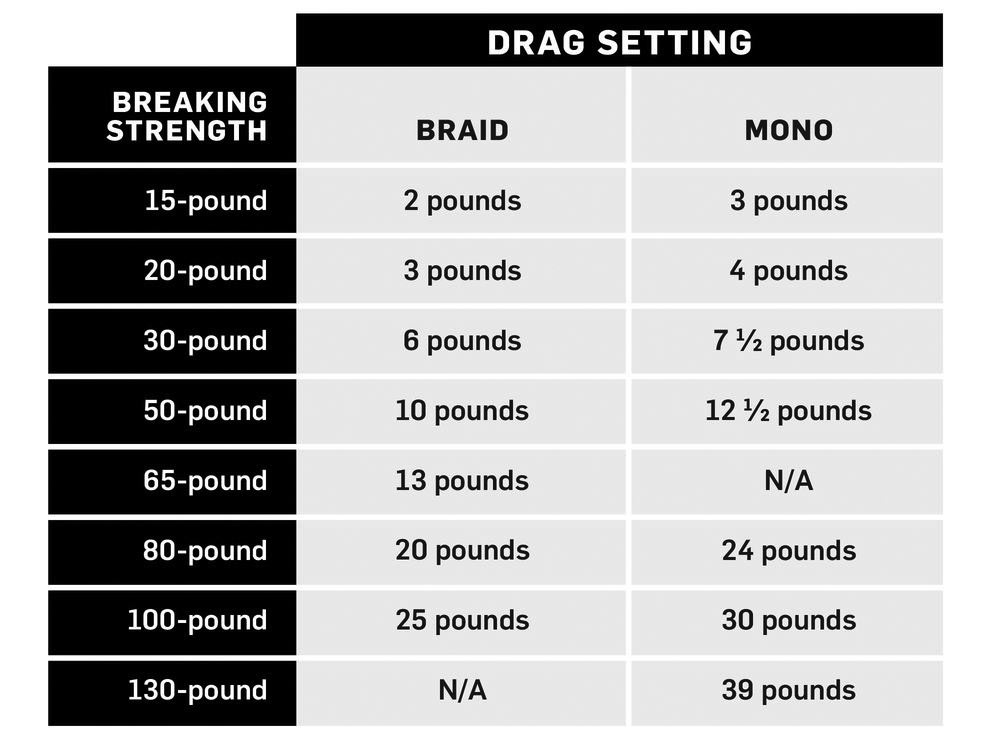 Before the birth of super braids, monofilament ruled the roost with drag-setting standards developed around the use of mono, which can stretch as much as 25 percent. While that stretch somewhat hinders hook-setting and the detection of subtle bites, especially when fishing in deep water, it also cushions against the sudden spikes in drag tension that occur when a sizable fish pounces on a bait, charges away from the boat, or surges into the air. Drag settings for braided lines, which lack the stretch of mono, are different. Their near-zero stretch and smaller diameters result in better hook-sets, faster sink rates and a much better feel. But the cushion against sudden spikes in tension is nonexistent, so lighter drag settings are in order. As a general rule, the proper drag setting for mono lines up to 20-pound-test is 20 percent of the breaking strength of the line. For 30- through 50-pound mono, it’s 25 percent of the breaking strength, and for 80- through 130-pound mono, it’s 30 percent. With braided lines up to 20-pound-test, set the drag at 15 percent of the line’s breaking strength. With 30- through 65-pound braid, set it at 20 percent. With braid that tests at more than 65 pounds, go with 25 percent. These are basic guidelines. The right drag setting can vary according to fishing conditions. A light drag is the right call when fishing light lines in open water for species such as fluke and weakfish. However,considerably more drag is required to keep large stripers, blackfish and sea bass from breaking off on structure when fishing around rocks or over a wreck.
Before the birth of super braids, monofilament ruled the roost with drag-setting standards developed around the use of mono, which can stretch as much as 25 percent. While that stretch somewhat hinders hook-setting and the detection of subtle bites, especially when fishing in deep water, it also cushions against the sudden spikes in drag tension that occur when a sizable fish pounces on a bait, charges away from the boat, or surges into the air. Drag settings for braided lines, which lack the stretch of mono, are different. Their near-zero stretch and smaller diameters result in better hook-sets, faster sink rates and a much better feel. But the cushion against sudden spikes in tension is nonexistent, so lighter drag settings are in order. As a general rule, the proper drag setting for mono lines up to 20-pound-test is 20 percent of the breaking strength of the line. For 30- through 50-pound mono, it’s 25 percent of the breaking strength, and for 80- through 130-pound mono, it’s 30 percent. With braided lines up to 20-pound-test, set the drag at 15 percent of the line’s breaking strength. With 30- through 65-pound braid, set it at 20 percent. With braid that tests at more than 65 pounds, go with 25 percent. These are basic guidelines. The right drag setting can vary according to fishing conditions. A light drag is the right call when fishing light lines in open water for species such as fluke and weakfish. However,considerably more drag is required to keep large stripers, blackfish and sea bass from breaking off on structure when fishing around rocks or over a wreck.
Let the Games Begin
Major drag-setting adjustments while fighting a fish often prove costly. If additional pressure is needed to stop or turn a fish, “feather” or “cup” the spool of your reel with your hand instead of tightening the drag. You can also pull sideways, resulting in more rod pressure. Should the fish make a sudden run or jump, the extra pressure is instantly abated by simply removing your hand from the spool and aiming the rod tip in the fish’s direction. Once the fish settles down, you can reapply additional pressure to shorten the battle. Among the many variables that increase drag tension during a battle are the resistance of the line, which steadily increases as a fish pulls more line during a long run. The initial drag setting should buy you enough time to give chase and reclaim lost line. However, when fighting a fish from a stationary boat or when a fish won’t slow down, begin backing off the drag to compensate for the increasing pressure on the line. As the fish settles down and you regain a safe amount of line, start tightening the drag little by little, without exceeding the original setting. This is important to remember, especially when targeting large fish that make long runs. Under these circumstances, we really like to fish rods of a fast to medium action with a slow tapering backbone. These rods provide a built in safety factor to help compensate for the increased drag resulting from a fish running off a lot of line, and the powerful head shakes that often accompany these runs. You need to be thinking that the rod is like a spring under pressure, once loaded it has kinetic energy working in its favor and with the right action will work in your favor by putting pressure on the fish through your reel’s drag. The rod’s bend will take pressure off you and apply it towards the fish. Heavier action rods can actually work against the angler, although they will eventually wear down a fish.
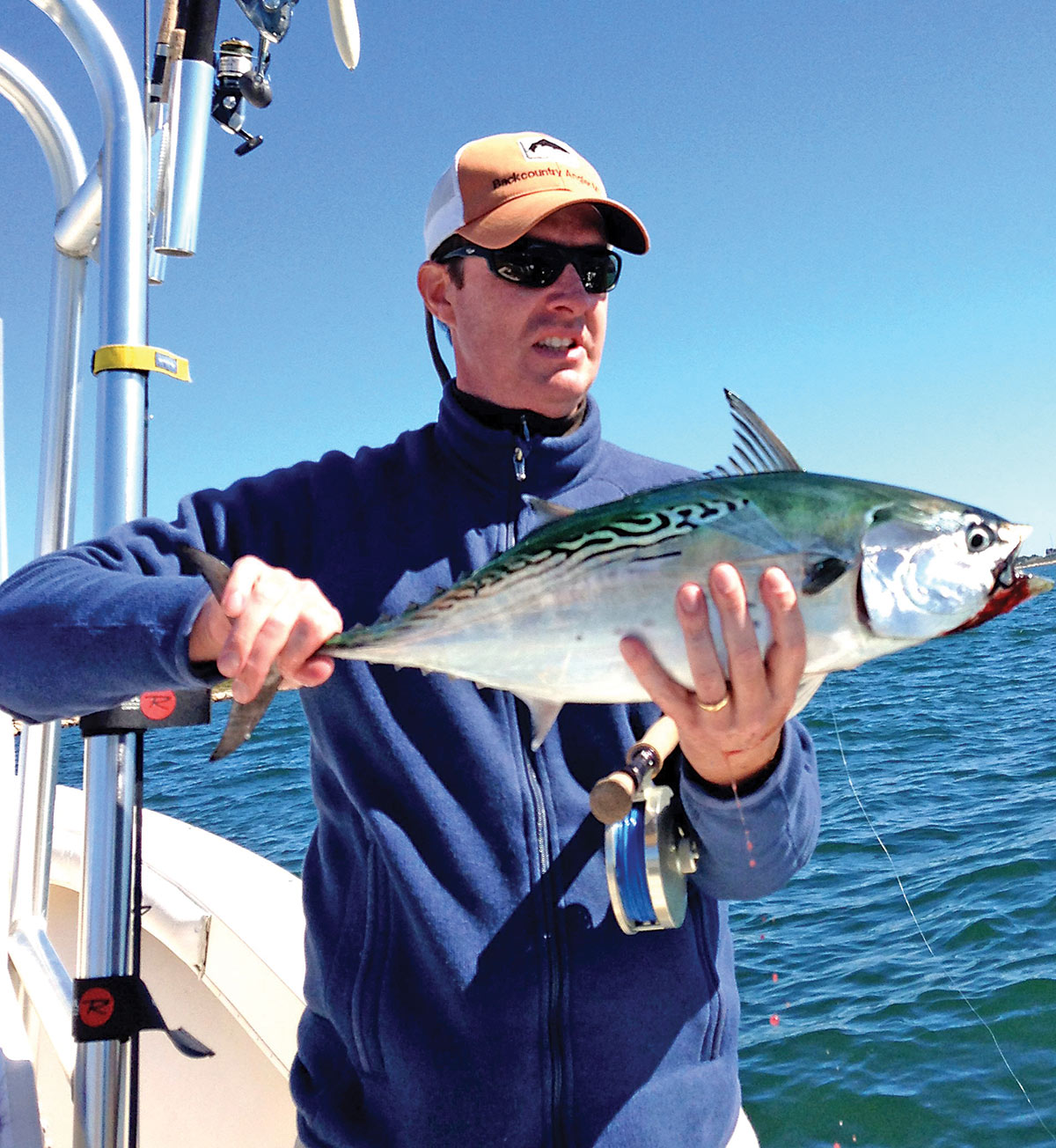
Consider the Dynamics
The last thing to consider is the dynamics of a full spool of line and a half spool of line with a fish on. You will be setting your drag with a full spool of line to your desired drag setting, say 10 to 13 pounds. If you hook a good fish that burns half the spool of line, the dynamics of the spool losing half its diameter will increase the drag by double. If we have the drag set to 10 to 13 pounds it’s now at 20 to 26 pounds. Many people get excited and try to tighten the drag, when in reality, they should be slowly loosening their drag to get back into the comfort range.
Setting drags on a reel is pretty easy once you know the proper way of doing it. Just remember to loosen all the drag knobs when you get home and wash down the reels with fresh water and allow to air dry. Releasing the pressure keeps the drag systems working properlylonger. It’s better to tighten them only when needed, like at the start of your next fishing trip. If you choose to do this, remember to reset your drag before that big striper comes along.
